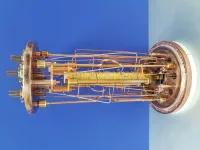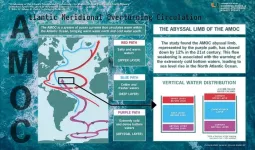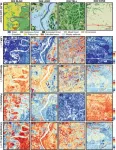(Press-News.org) In the 1930s, it turned out that neither the energy nor the momentum balance is correct in the radioactive beta decay of an atomic nucleus. This led to the postulate of "ghost particles" that "secretly" carry away energy and momentum. In 1956, experimental proof of such neutrinos was finally obtained. The challenge: neutrinos only interact with other particles of matter via the weak interaction that is also underlying the beta decay of an atomic nucleus. For this reason, hundreds of trillions of neutrinos from the cosmos, especially the sun, can pass through our bodies every second without causing any damage. Extremely rare neutrino collisions with other particles of matter can only be detected with huge detectors.
Solar neutrinos brought another ground-breaking revelation: the three types of neutrino known to date can transform into each other. However, these "neutrino oscillations" had a serious consequence for the world view of particle physics. Previously, it was assumed that neutrinos had no rest mass, like photons. This would be compatible with the standard model of particle physics, the best description of the particle world to date. However, the oscillations forced a rest mass for neutrinos - a further indication that new physics must exist beyond the standard model.
Knowing the exact rest mass of the neutrino would therefore be an open sesame into the unknown world of new physics. Unfortunately, you cannot simply place a neutrino on a scale. This requires extremely complex experiments on technically accessible physical processes involving neutrinos. "One way is the beta decay of tritium," explains Christoph Schweiger, doctoral student in Klaus Blaum's department at the Max Planck Institute for Nuclear Physics. Here, one of the two neutrons in the superheavy hydrogen decays into a proton and emits an electron and a neutrino, thereby transforming the atom into lighter helium. This process is "weighed" by the KATRIN experiment at the Karlsruhe Institute of Technology.
"The complementary path is the electron capture of the artificial isotope holmium-163," continues Schweiger. Here, the atomic nucleus captures an electron from the inner electron shell, whereby a proton is converted into a neutron, resulting in the element dysprosium-163. This also releases a neutrino, amongst other things. The international ECHo collaboration, in which the Heidelberg scientists are involved, attempts to measure this decay process energetically with extreme precision. According to Einstein's E = mc2, mass and energy are equivalent, so measuring energy can be equated with weighing masses. As a "calorimeter", ECHo measures extremely accurately the total energy released in this decay: This corresponds to a maximum of the Q value minus the rest mass of the neutrino released. For this purpose, the holmium-163 isotope is incorporated into a layer of gold atoms.
"However, these gold atoms could have an influence on holmium-163," explains Schweiger: "It is therefore important to measure the value of Q as precisely as possible using an alternative method and to compare it with the calorimetrically determined value in order to detect possible systematic sources of error." This is where the Heidelberg pentatrap experiment and Schweiger's doctoral thesis come into play. Pentatrap consists of five so-called Penning traps. In these traps, electrically charged atoms can be captured in a combination of a static electric and magnetic field. These ions perform an intricate "circle dance", which allows their mass to be determined with extreme precision. "With an Airbus A-380 with a maximum load, you could use this sensitivity to determine whether a single drop of water has landed on it," says the physicist, illustrating the capabilities of this super scale.
In principle, a Penning trap works like a swing. If you place two children of different weights next to each other on two swings of the same type and push them equally hard, you will gradually observe a shift in the swing frequencies. This can be used to calculate the difference in weight between the two children. In the case of the pentatrap experiment, this is the difference in mass between a holmium-163 ion and a dysprosium-163 ion. In addition, the faster both children swing, the sooner the result is obtained, which is also much more accurate for the same observation time than for slow swinging. For this reason, the team removed 38, 39 and 40 electrons from the "highly charged" ions in three different series of measurements, which makes their "circle dance" considerably faster. "If everything works, a measurement will only take a few weeks," says Schweiger.
From the differences in mass as a result of various frequency measurements, via E = mc2 the Heidelberg scientists were finally able to determine a Q value for electron capture that was 50 times more precise than before. "The contribution of the three theory groups, including Christoph Keitel's group here at the institute, was just as important as our measurement," emphasises Schweiger. In addition to the frequency difference between the two ions, a second variable has a significant influence on the Q value determined: the energy stored in the remaining electron system of a highly charged ion. As such a large ion is a multi-particle system, the calculation was correspondingly complex. It turned out that the calculations resulted in almost exactly the same Q values for the three measured charge states with 38, 39 and 40 electrons removed. This made it clear that systematic uncertainties in experiment and theory could be ruled out, Schweiger emphasises enthusiastically. And what does this mean for the neutrino masses?
KATRIN determined the most precise upper limit to date of the neutrino mass by "weighing" at 0.8 electron volt per speed of light squared, which corresponds to an unimaginable 0.0000000000000000000000000000000000014 kilogram! This order of magnitude of 10–36 corresponds approximately to the weight ratio between four raisins and the sun. And that is only an upper limit. The analysis of the estimated mass distribution in the universe even arrives at a significantly lower upper limit of the neutrino masses of 0.12 electron volt per speed of light squared. "However, this analysis is highly complex and depends on the cosmological model used," says Schweiger. In any case, it is clear that anyone who wants to weigh neutrinos faces extreme challenges at the edge of what is technically possible. Against this background, the Heidelberg result is a major step forward on the way to solving the mystery of neutrino masses.
(Roland Wengenmayr / MPIK)
END
Ghost particle on the scales
2024-04-19
ELSE PRESS RELEASES FROM THIS DATE:
Light show in living cells
2024-04-19
Observing proteins precisely within cells is extremely important for many branches of research but has been a significant technical challenge - especially in living cells, as the required fluorescent labelling had to be individually attached to each protein. The research group led by Stefan Kubicek at CeMM has now overcome this hurdle: With a method called "vpCells," it is possible to label many proteins simultaneously, using five different fluorescent colours. This automated high-throughput approach, aided by AI-assisted image recognition, opens up entirely new applications in various disciplines, from fundamental cell biology to drug discovery. The study ...
Climate change will increase value of residential rooftop solar panels across US, study shows
2024-04-19
Graphic
Climate change will increase the future value of residential rooftop solar panels across the United States by up to 19% by the end of the century, according to a new University of Michigan-led study.
The study defines the value of solar, or VOS, as household-level financial benefits from electricity bill savings plus revenues from selling excess electricity to the grid—minus the initial installation costs.
For many U.S. households, increased earnings from residential rooftop ...
Could the liver hold the key to better cancer treatments?
2024-04-19
PHILADELPHIA – Liver inflammation, a common side-effect of cancers elsewhere in the body, has long been associated with worse cancer outcomes and more recently associated with poor response to immunotherapy. Now, a team led by researchers from the Abramson Cancer Center and Perelman School of Medicine at the University of Pennsylvania has found a big reason why.
In their study, published today in Nature Immunology, the researchers discovered that cancer-induced liver inflammation causes liver cells to secrete proteins called serum amyloid A (SAA) proteins, which circulate through the body and hinder the ability of T cells—major anticancer weapons of the immune system—to ...
Warming of Antarctic deep-sea waters contribute to sea level rise in North Atlantic, study finds
2024-04-19
Analysis of mooring observations and hydrographic data suggest the Atlantic Meridional Overturning Circulation deep water limb in the North Atlantic has weakened. Two decades of continual observations provide a greater understanding of the Earth’s climate regulating system.
A new study published in the journal Nature Geoscience led by scientists at University of Miami Rosenstiel School of Marine, Atmospheric, and Earth Science, and the National Oceanic and Atmospheric Administration’s Atlantic ...
Study opens new avenue for immunotherapy drug development
2024-04-19
HOUSTON ― In a new study published today in Nature Biomedical Engineering, researchers at The University of Texas MD Anderson Cancer Center have designed a new method for developing immunotherapy drugs using engineered peptides to elicit a natural immune response inside the body.
In preclinical models of locally advanced and metastatic breast cancer, this method improved tumor control and prolonged survival, both as a monotherapy and in combination with immune checkpoint inhibitors.
“Amino acids are the building blocks of life and, when a few of them are linked together, they create a peptide. ...
Baby sharks prefer being closer to shore, show scientists
2024-04-19
Remember #BabyShark? And no, this was not the very catchy song for kids that took the internet by storm. Earlier this year, social media was abuzz with stunning footage of a newborn great white shark, captured by a flying drone.
Now, marine scientists have shown for the first time that juvenile great white sharks select warm and shallow waters to aggregate within one kilometer from the shore. These results, published in Frontiers in Marine Science, are important for conservation of great white sharks – especially as ocean temperatures increase due ...
UBC research helps migrating salmon survive mortality hot-spot
2024-04-19
When Kevin Ryan and the other hardworking volunteers at Mossom Creek Hatchery in Port Moody, B.C. release young coho smolts into the ocean, they’re never quite certain how many will return as adults.
Mossom releases between 5,000 and 10,000 coho smolts each year, and is one of the few hatcheries to release coho directly into the ocean, rather than into a river. Until now, no research had looked at the success of direct ocean releases of coho.
UBC researchers used acoustic telemetry to tag and track coho on their journey. The results were revealing: ...
Technical Trials for Easing the (Cosmological) Tension
2024-04-19
Thanks to the dizzying growth of cosmic observations and measurement tools and some new advancements (primarily the “discovery” of what we call dark matter and dark energy) all against the backdrop of General Relativity, the early 2000s were a time when nothing seemed capable of challenging the advancement of our knowledge about the cosmos, its origins, and its future evolution.
Even though we were aware there was still much to uncover, the apparent agreement between our observations, calculations, and theoretical framework was indicating that our knowledge of the universe was set to grow significantly and without ...
Mapping plant functional diversity from space: HKU ecologists revolutionize ecosystem monitoring with novel field-satellite integration
2024-04-19
An international team of researchers, led by Professor Jin WU from the School of Biological Sciences at The University of Hong Kong (HKU), has made a promising advancement in mapping plant functional traits from space using time-series satellite data. The study, published in Remote Sensing of Environment, showcases the innovative combination of the Sentinel-2 satellite mission and its dynamic time-series capabilities. This innovative approach not only unlocks a deeper understanding of essential foliar traits, providing crucial insights ...
Lightweight and flexible yet strong? Versatile fibers with dramatically improved energy storage capacity
2024-04-19
The latest wearable devices, such as Samsung's Galaxy Ring and Apple's Vision Pro, are taking healthcare a step further and even enabling people to work virtually. Given the characteristics of wearable devices that require them to be small and lightweight, there is an inevitable limitation on battery capacity, still presenting a technical barrier to incorporating a variety of functions. In order for wearable devices to fully realize the imagined life, it is necessary to develop a lighter and more fromlessenergy storage method.
The Korea Institute of Science and Technology (KIST) announced that a joint research team led by Dr. Hyeonsu Jeong ...










